There is a potential for new boxwood blight infections in the next few days according to https://uspest.org/risk/boxwood_app.
Protective fungicide applications should remain in effect or be initiated immediately for Boxwood Blight. The disease may be sporulating and spreading amongst plantings if present (or may come into your nursery via shipments) within the next few days. According to https://uspest.org/risk/boxwood_app, this is the first legitimate potential for boxwood blight spread and new infections in 2020 for southern NJ. Please continue preventative/protectant fungicide applications utilizing; chlorothalonil (FRAC Group M05), mancozeb (FRAC Group M03), and QoI-fungicides (FRAC Group 11) in a rotation. Please contact Tim Waller at twaller@njaes.rutgers.edu for more information or questions.
UPDATES:
Growing Degree-days as of 6/4/20 using NEWA
GDD50 = Growing Degree-Day with min. temp. set to 50F
Upper Deerfield = 548.5 GDD50 ; Howell = 407.5 GDD50 ; Pequest = 335.0 GDD50
How to use growing degree-day resources: https://plant-pest-advisory.rutgers.edu/using-growing-degree-day-calculators-nursery-pest-and-pathogen-updates-important-resource-links/
Pests: The number of accumulated growing degree-days has been rapidly increasing with higher and higher temperatures (approaching normalcy). Throughout New Jersey various adult borers will be emerging, these include; Lilac, Emerald Ash, Banded Ash Clearwing, and Peach Tree borers. Additionally, Ambrosia beetles (multiple species) will be in-flight and actively seeking egg-laying locations. Pyrethroids should be used as preventative sprays but should be targeted to the bases of susceptible hosts such as Magnolias, Yellow bud, Red bud, Japanese maples, Styrax, and Hybrid chestnuts. These Targeted applications are geared towards protecting beneficial insect populations. The eggs of many scale insects are hatching now, leaving their ‘crawler’ stage vulnerable to pesticide applications. Scale insect species to be mindful of; Maskell, Oystershell, Taxus, Euonymus, Prunicola, Oak lecanium, Japanese maple, Cottony maple, Calico, Golden oak, and Juniper scale. Aphids, especially on roses, and mites will be increasing their populations with the warmer weather and should be minded when in high density. Management should utilize an appropriate pesticide rotation when necessary, as these pests are prone to developing pesticide resistance quickly. Four lined plant bugs, basswood lacebug, and multiple leaf and plant hoppers have been reported south of NJ and should be monitored and treated for as appropriate through the coming weeks as many of these insects are capable of vectoring plant viruses. Lilac leafminer, Juniper tip-midge, and Pin oak sawfly may also be an issue in some locations. Red-headed flea beetle will be hatching between 250-480 GDD50, with adults emerging between 500-1000 GDD50. A second generation of larva will then be active between 1,570 to 1860 GDD50, emerging later 1,878 to 2,318 GDD50. Reminder, keep an eye out for the Box tree moth that has been identified approaching the border of US and Canada. This pest has prompted APHIS importation amendments for Boxwood, Euonymus, and Illex. Gypsy moths, Bagworms, Mimosa webworm will be hatching or emerging in many parts of the state very soon, (in some locations they may already have).
Please visit https://njaes.rutgers.edu/pubs/publication.php?pid=E334 for more specific information.
Understanding and approaching plant diseases: The weather as of late has been conducive to plant disease for much of NJ. Higher humidity, increasing temperatures, and prolonged periods of leaf wetness (particularly at night) are considered the factors associated with the ‘sweet spot’ of disease development. Regularly scheduled protectant fungicide applications should be continued if a pathogen or history-thereof is suspected. Compounds should be rotated to guard against pesticide resistance to any one compound (rotating high/medium-risk with low-risk materials). Also, any steps geared towards increasing airflow, reducing wet-feet, limiting mechanical injury, and reducing leaf wetness duration or excessive overhead irrigation during this warm and humid period will benefit disease management efforts.
Please visit: https://njaes.rutgers.edu/pubs/publication.php?pid=E036 for more specific information on individual plant and pathogen species.
Other timely diseases to note: Many needle cast diseases of conifers should be well into a fungicide application schedule, utilizing chlorothalonil, azoxystrobin, basic sulfate coppers, mancozeb, and T-methyl in a rotation of materials. Many of these compounds will also control Pine needle rust that may become prevalent in some locations, especially those locations with high levels of goldenrod or aster weeds. Botrytis and powdery mildew are still a concern in many parts of the state, especially those that are experiencing cooler nighttime temperatures. What fungicide used is dependent on the specific host species in many cases. Please refer to the link above for specific information. Fungal and bacterial leaf spots are very common and often only intensively treated if those plants are to enter the market the next season. However, in areas prone to disease or severe cases (defoliation occurs), treatments should be preventative and conducted throughout the season. Sooty mold grows on the honeydew produced by large populations of sap-sucking insect pests (aphids, scales, leaf/plant hoppers). Controlling the insect pests is our best option to reduce this unsightly disease. In severe casts of sooty mold, plants can be washed free of this fungal growth using mild detergents. Phytophthora diseases are ever present at the nursery, however cultural practices such as sterilized potting media, cleaning tools and machinery regularly, efforts to reduce wet-feet or overwatering, and sterilization or treatment of recycled water can have profound impacts on the expression or spread of Phytophthora diseases. When fungicide applications are required, materials like phosphorus acids, fosetyl-Al (Aliette), mefenoxam (Ridomil), and etridiazole + T-methyl (Banrot) are commonly used. Rotation of these compounds and proper disease identification are incredibly important as many root-rotting pathogens have a strong propensity towards developing pesticide resistance.
Please consider the Rutgers Plant Diagnostics Laboratory for pest/pathogen identification concerns: https://njaes.rutgers.edu/plant-diagnostic-lab/
Online discussions and credit events
NJNLA pesticide credit webinar/course: Invasive Forest Pests: New Threats and Their Management (6/10/20): https://www.njnla.org/events/EventDetails.aspx?id=1383945
Webinar – June 10th, 2020 – 7:00pm to 8:30pm. Invasive Forest Pests: New Threats and Their Management. You must include your email address when registering. Information to join Webinar will be sent just prior to the start. Cost: $35/Member, $50/Non-Member. NJ Pest Credits: 3A (Ornamentals) – 3, PP2 (Private Applicator Category) – 3, 2 (Forest) – 3, 8C (Campgrounds) – 3, 9 (Regulatory) – 3,. CNLP: Environment – 1.5, LTE/LTCO: 1 CEU, NJUCF: 1 CEU and ISA is still pending.
EPA information pertaining to online credits for licenses expiring in 2020: https://pestmanagement.rutgers.edu/increased-online-ceus-for-licenses-expiring-2020-act-now/
Ask the Agent (every Wednesday @ 7:00pm): https://go.rutgers.edu/t7wjkit1 . A new online forum has been created where anyone can log-on and speak with Rutgers Cooperative Extension agents (multiple agents from multiple counties)
NJNLA- Wine Down Wednesdays (every first and third Wednesday @ 7:00pm-8:00pm). Email: Lori Jenssen @ njnla.director@gmail.com. This is a great opportunity to speak with other green-industry businesses.
Rutgers nursery survey, advisory, and other resources:
Please take the 2020 Nursery Industry Survey: https://forms.gle/dUjLxaiu6qDQYYsRA
The new nursery agents have prepared a preliminary survey aimed at understanding the needs of our growers and clientele, i.e. you. Please take a moment to complete the survey, as this type of information really helps the agents secure grant funding to deal with the problems you actually have. Thank you!
Subscribe to the NJAES YouTube webpage: https://www.youtube.com/user/RutgersNJAES/
RU Sustainable Nursery Production website: https://njaes.rutgers.edu/nursery/
March meeting PDF: https://njaes.rutgers.edu/nursery/documents/2020%20SJ%20Nursery%20Meeting%20Proceedings.pdf


 wasps found throughout the U.S. and burrow holes in the soil. Even with their large size, dangerous appearance and “dive-bombing” habit, adult Cicada killer wasps rarely come in contact with people and it is rare they will sting. The males of this species will make “dive-bombing” flight patterns, but do not have a stinger and an attack would not result in a sting. The female’s tubular egg-laying structure on the rear end can function as a very weak stinger. Her mild sting is similar to a slight pin scratch and is not considered by most people to be painful. Rutgers Cooperative Extension has more information on the
wasps found throughout the U.S. and burrow holes in the soil. Even with their large size, dangerous appearance and “dive-bombing” habit, adult Cicada killer wasps rarely come in contact with people and it is rare they will sting. The males of this species will make “dive-bombing” flight patterns, but do not have a stinger and an attack would not result in a sting. The female’s tubular egg-laying structure on the rear end can function as a very weak stinger. Her mild sting is similar to a slight pin scratch and is not considered by most people to be painful. Rutgers Cooperative Extension has more information on the 